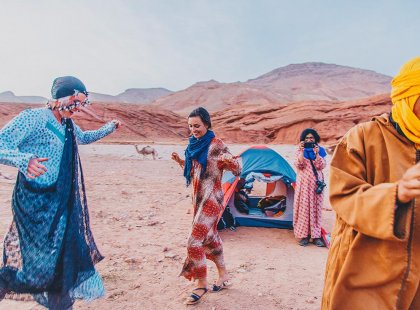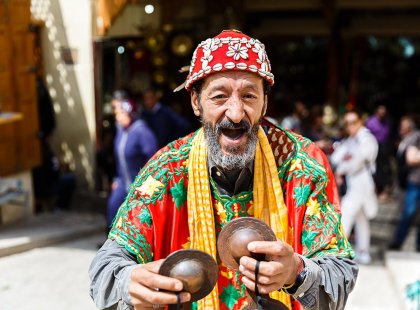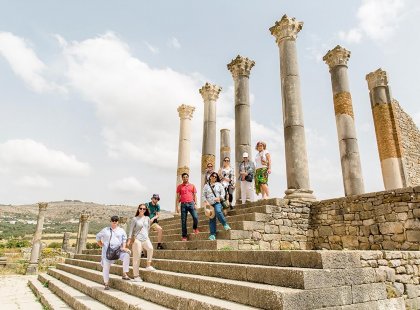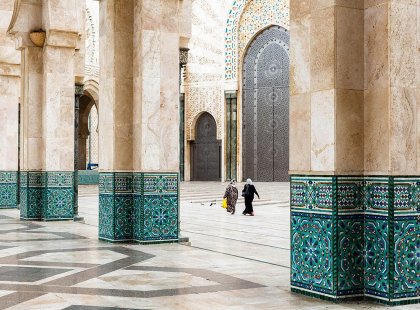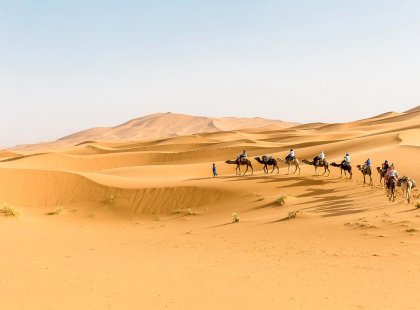Morocco Encompassed
18 days
from Casablanca Apparthotel to Grace Marrakech
From
$ 1905
Duration18 days
Visit Morocco on an all-encompassing adventure from Casablanca to Marrakech. Visit Morocco and discover this land of contrasts - sparkling coastlines, soaring mountains, lush valleys and the vast, unforgettable Sahara Desert. Travel in the footsteps of pirates, sultans and desert nomads, exploring the colonial architecture of Casablanca, the ancient Roman ruins of Volubilis, the medieval city of Fes and the intricate clay architecture of the Ait Benhaddou Kasbah. Enjoy the warm local hospitality and embark on exotic adventures - riding a camel over Saharan dunes, hiking in the High Atlas Mountains and haggling for treasures in bustling souqs. Take an exhilarating journey to absorb the extraordinary sights of mysterious Morocco.
-
Duration: 18 daysService level: Standard
-
Starts in: Casablanca ApparthotelPhysical Grading: Light
-
Ends in: Grace MarrakechAges: 15+
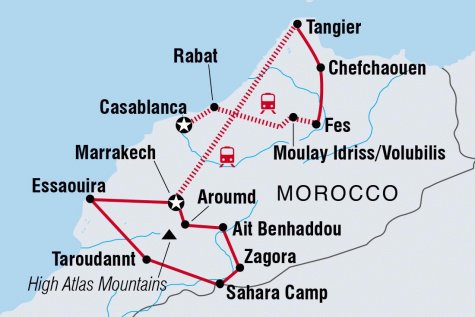
Itinerary
Day 1: Casablanca
Start place: Casablanca Apparthotel
Salaam Aleikum! Welcome to Morocco. Your adventure begins today with a welcome meeting at 6pm – check with hotel reception to confirm the time. If you can't arrange a flight that will arrive in time, you may wish to arrive a day early. We'll be happy to book additional accommodation for you (subject to availability). If you're going to be late, please inform the hotel reception. We'll be collecting your insurance details and next of kin information at this meeting, so please have these on hand. As there's not much free time included in Casablanca on this trip, we highly recommend you arrive a day or two early so you can explore. Modelled after Marseille in France, the city is famous for its art deco buildings and the modern-day masterpiece, the Hassan II Mosque. A pleasant way to spend the day exploring Casablanca is to wander the old medina and the city walls, then jump in a taxi to visit the Quartiers des Habous, the new medina. Finish the day with a walk along the Corniche, watching the locals play football on the beach, or take it easy with a glass of sweet mint tea in one of the many great cafes.
Note: Please be aware that some of our travellers to Casablanca are being approached by locals offering excursions before their Intrepid trip commences. This has been particularly prevalent in and around the hotels used by Intrepid. These guides are in no way connected to Intrepid Travel and we cannot guarantee the safety or quality standards of their tours. We strongly advise customers against joining any tour offered by unauthorised guides. Intrepid Travel assesses the safety of all optional excursions offered by our tour leaders. If you would like more information on the excursions available, please contact us before you travel or see the Intrepid-branded notice in the reception of your hotel.
Note: Please be aware that some of our travellers to Casablanca are being approached by locals offering excursions before their Intrepid trip commences. This has been particularly prevalent in and around the hotels used by Intrepid. These guides are in no way connected to Intrepid Travel and we cannot guarantee the safety or quality standards of their tours. We strongly advise customers against joining any tour offered by unauthorised guides. Intrepid Travel assesses the safety of all optional excursions offered by our tour leaders. If you would like more information on the excursions available, please contact us before you travel or see the Intrepid-branded notice in the reception of your hotel.
Day 2: Rabat/Moulay Idriss
Today take an early morning one-hour train to the historical town of Rabat. Rabat's history is long and colourful, having been host to Roman settlements, pirates and more recently the Moroccan parliament. It contains numerous fine Arab monuments, some dating from the 10th to 15th century Almohad and Merenid dynasties, and others that are far older. The earliest known settlement is Sala, occupying an area now known as the Chellah. Store your luggage and spend a few hours strolling through the city's old quarter, then walk up to Kasbah des Oudaias and enjoy views over the Atlantic Ocean. Continue on to Meknes by train (approximately 3 hours), before taking a 45-minute taxi through scenic countryside to the sacred pilgrimage village of Moulay Idriss. Once forbidden to non-Muslims, explore the delightful medina of this ancient town that offers an excellent insight into traditional Moroccan life. See where the faithful gather to pay homage at the tomb of Moulay Idriss I, who was the great-grandson of Mohammed and brought Islam to Morocco. At sunset, enjoy great views over the plains of Volubilis below. Your accommodation for the night is in a guesthouse/homestay with a local family. Bathroom facilities may be shared and you may be sharing a room with two or three others.
Meals: B, D
Day 3: Volubilis/Fes
Today, take a guided tour of the archaeological site of Volubilis. World Heritage-listed Volubilis was once a provincial Roman capital, a distant outpost of the empire, and the remains make an undeniably impressive sight. Upon arrival, take a tour around the ruins with a local guide. Please remember to pack drinking water, hat, sunglasses and sun cream for this tour as it may get hot and you will be exposed to the sun. And, of course, don’t forget to take your camera as the town is filled with fantastic mosaics along the Decumanus Maximus, many of which remain intact. After time spent imagining Volubulis as the bustling city it once was, return to the nearby imperial city of Meknes, where you'll have a few hours to explore. In the 17th century Sultan Moulay Ismail turned Meknes from a provincial town to a spectacular Imperial city, building his own version of Versailles with labour force of over 25,000 slaves. The adventurous may want to try a camel burger for lunch at a local restaurant in the medina. In the afternoon, take a one-hour train to Fes, where you'll spend the next two nights. Fes is the spiritual and cultural heart of Morocco; vibrant, noisy, fascinating and overwhelming – a visual and pungent feast for the senses – with a huge, well-preserved medieval old city that’s the mother of all medinas.
Meals: B, L
Day 4: Fes
Take a guided group walking tour of the old city, known locally as Fes el Bali. Step back into the Middle Ages in the labyrinth of the Medina, which is alive with craftsmen, markets, tanneries and mosques. Pass donkeys piled high with goods (this is one of the largest car-free urban zones in the world) and explore the specialty sections that divide the souk. Look out for the Medersa Bou Inania, one of the city's most beautiful buildings, which has recently been restored and is now open to tourists. Visit Medresse el Attarine and the splendid Funduk Nejjarine, a beautifully restored 18th century inn. You'll also see the famous tannery, known for the iconic view overlooking its dye pits, and a ceramics factory where you can see potters working in the traditional way. In the evening, enjoy a delicious group dinner of Moroccan specialities like harira (chickpea soup) and chicken-stuffed pastilla with couscous.
Meals: B
Day 5: Chefchaouen
Take a local four-hour bus to the isolated town of Chefchaouen today. Chefchaouen, or the ‘blue city’, is arguably one of the prettiest places in Morocco. Set against a wide valley and nestled between two peaks in the stunning Rif Mountains, Chefchaouen may take you by surprise. Its medina has been lovingly cared for with striking blue and whitewashed houses, red-tiled roofs and artistic doorways. Much of Chefchaouen was recreated by Andalusian refugees escaping the Reconquistia, so you might feel like you're in the hills of Spain while exploring its streets. Ease into the relaxed pace of life in this rural retreat. Take a stroll through the ancient medina and shop for handicrafts, go hiking in the Rif mountains or simply sit at a cafe and enjoy the pleasure of time passing by. If you're feeling peckish, the goats' cheese on offer is a popular treat enjoyed by many visitors.
Meals: B
Day 6: Chefchaouen
Today is a free day to explore Chefchaouen. Perhaps take a guided tour of the sights, sounds, and smells of the medina, or sample the delicious local goat cheese at a cafe in the Plaza Uta el-Hammam. Admire the architecture of the 15th-century Grand Mosque (closed to non-Muslims) and browse the shops in the square selling woven goods and small sweets. Also within the plaza is the walled fortress of the Kasbah. Wander through the tranquil gardens inside, check out the ethnographic museum and soak in wonderful views from the rooftop. Alternatively, you might prefer to get out of town and enjoy a hike and picnic in the surrounding hills. In the evening, tuck into a tagine at a local restaurant or visit a hammam, a traditional Moroccan spa.
Meals: B
Day 7: Tangier
Today take a three-hour private minibus journey to the coastal town of Tangier, a place of strategic importance to the Mediterranean and the gateway to Africa. Once a hotspot for artists, secret agents and millionaires, Tangier has been going through something of a renaissance of late thanks to the arrival of a new monarch in Morocco in 1999. Mohammed VI of Morocco and his forward-thinking ideas about commerce and tourism has suddenly woke up the community to the potential of this city. Today, the city's medina and kasbah are well worth exploring, as are the cafes and patisseries around the Place de la France in the Ville Nouvelle. Perhaps visit the American Legation Museum, the former palace of Dar el-Makhzen or the Caves of Hercules. The recently reconstructed beach promenade is lined with great restaurants. Perhaps enjoy a fresh seafood dinner by the port, before boarding an overnight sleeper train bound for Marrakech.
Meals: B
Day 8: Marrakech
Arrive early into Marrakech on the overnight train. The day is free for you to explore. Marrakech is a feast for the senses. Explore the Medina and the city's seemingly endless mosaic of souqs. Each is devoted to a separate trade: pottery, woodwork, copper, leather, carpets and spices. Perhaps visit the well-known Koutoubia Mosque and its 12th-century minaret, which was the famous prototype for the Giralda tower in Seville. Take a wander through the tropical gardens of the French painter Jacques Majorelle (now owned by Yves Saint Laurent). You might like to check out the Palais Bahia, a superb example of Muslim architecture, or the ruins of the Palais Badi, reputedly one of the most beautiful palaces in the world in its time. The Saadian tombs are a recently uncovered gem of the Medina. All of the above can be a challenge to locate, but that's all part of the experience of exploring the medinas of Morocco. In the evening, join the thronging crowds for an optional dinner in the Djemaa el Fna, the city's main square. When night falls it transforms into a hive of activity. Henna-painters, performers and storytellers share the square with a street food bazaar, packed with stalls loaded with Moroccan delicacies.
Day 9: Marrakech
Today is a free day for you to discover Marrakech further. Perhaps explore the Medina for some shopping, where every step brings a new smell, a new sight or a new gift to buy. In the seemingly endless mosaic of souqs, each is devoted to a separate trade: pottery, woodwork, copper, leather, carpets and spices. Watch skilled artisans perfect their craft, practise your haggling skills or take a break from the hustle to sip on tea or share a tajine, filled with the pure scent of Morocco. You can also venture out of Marrakech for a day trip; if you feel energetic, why not try one of the famous day walking trips. Oukaimeden or Ourika Valley are great places not far from Marrakech. If you would like to relax after the first part of your adventure, ask your leader to help you out with booking a session in one of the famous Moroccan Hammams.
Meals: B
Day 10: Aroumd
Today, take a short drive up the towering High Atlas Mountains to the village of Imlil (approximately 2 hours), photographing snow-dappled mountains and valleys in full flower along the way. On arrival, store your main luggage and load daypacks onto pack mules before walking into traditional mountain village life with a one-hour trek up to the peaceful village of Aroumd. If you feel like the walk is too strenuous then there's the option of riding the mule. Perched on a rocky outcrop, the remote village of Aroumd offers stunning views across the High Atlas Mountains and a unique opportunity to experience traditional Berber culture. Spend the night in a family-run mountain home (gite) in Aroumd. Surrounded by the smell of woodstoves and bread, meet the host family and enjoy Berber hospitality and food. Facilities at the homestay are shared (both the bathroom and sleeping arrangements) but cosy, comfortable and definitely a unique Intrepid experience. Use the rest of the day to explore the village and the surrounding farmlands. If the group are up for it, there will be a chance to hike of around eight kilometres to the pilgrimage shrine of Sidi Chamharouch (approximately 4 hours return). Regardless of fitness levels, the gentle pace of Aroumd makes it a special place to explore beyond the reach of the modern world.
Meals: B, L, D
Day 11: Ait Benhaddou
This morning journey along mountain roads and over Morocco's highest pass, Tizi n'Tichka (2,260 metres), to Ait Benhaddou on the edges of the Sahara (approximately 6 hours). Perched on a hilltop and almost unchanged since the 11th century, Ait Benhaddou is one of Morocco's most iconic site. It was once an important stop for caravans passing through as they carried salt across the Sahara, returning with gold, ivory and slaves. Today its grand kasbah has been listed as a World Heritage site, with its fortified village being a fine example of clay architecture. If you think you recognise the place, you probably do, as the town has a long list of film and TV credits, including Lawrence of Arabia, Game of Thrones and Gladiator. Enjoy a walk through the winding streets of old town, making your way to the top of the hill, from where you can enjoy the views across the surrounding plains. In the evening, why not join a simple cooking demonstration of Morocco's most famous cuisine: couscous and tagine. The locals will explain the secrets and subtleties of these traditional meals, as the ladies of the kitchen prepare a feast.
Meals: B
Day 12: Zagora
This morning you'll journey south towards the Sahara, stopping in the regularly used film location of Ouarzazate along the way (approximately 5 hours in total). Continue to travel through the lush Draa Valley to Zagora, a small oasis town on the Sahara fringe that is perfect for an overnight stop. Take a stroll through the palm groves, explore the ksars and wander around the surrounding countryside.
Meals: B
Day 13: Sahara Camp
Continue along the rugged and desolate Jbel Tadrart ranges and through seas of sand and past the occasional desert oasis of date palms to the township of Tamegroute. Visit an intriguing library filled with ancient scripts of science, literature, the Koran and stories of the prophet Mohammed (subject to unregulated opening times). Join a local guide to uncover the underground Kasbah and its unique ceramic pottery industry. Leave Tamegroute behind and carry on driving to the end of the road at the frontier town of M'Hamid (approximately 1 hour). From here, take a short camel ride through the dunes, where you’ll jump into 4WD vehicles. The rough track runs parallel to the Algerian border, across the stony Hamada desert, whose only populace is small scatterings of nomadic people and their camels. The group will reach the massive Erg Chigaga dunes in the late afternoon. An erg is a vast sea of shifting wind-swept sand that's formed into picturesque, undulating crests and valleys. The Erg Chigaga is one of the world's iconic landscapes, with towering dunes up to 150 metres in height.
Meals: B, D
Day 14: Taroudant
Today rejoin the minivan and venture towards the market town of Oulad Brhhil, sometimes called ‘Little Marrakesh’. The journey should take around eight hours in total. This drive goes through desert scenery and along a route that's a reserve for the indigenous argan trees. Argan oil is highly prized for its culinary, cosmetic and medicinal uses and is only produced in Morocco, and is certainly a trademark of Morocco around the world. If you're lucky, the group might come across the famous image of goats climbing these trees in search of nuts. Please note that this is a long travel day, and you won't arrive at tonight's accommodation until late afternoon/early evening. The riad (house) tonight is 45 kilometres outside of Taroudant and offers the chance to relax by the pool or take a steamed bath.
Meals: B
Day 15: Essaouira
In the morning, take to the souqs and haggle with local traders for silver jewellery or colourful Moroccan ceramics and mosaics. Afterwards, leave the valleys of the High Atlas Mountains behind and head west to the coastal town of Essaouira (approximately 5 hours). The name Essaouira means image, which is appropriate since it's such a picturesque town. Its charm is undeniable; within the stone ramparts you'll find whitewashed houses with bright blue shutters, art galleries and wood workshops. This laidback artists' town is a former Portuguese trading colony and was once home to sizeable British and Jewish populations. The town faces a group of rocky islands, called the Mogador, and is surrounded by an expanse of sandy beaches and dunes. It's still a busy fishing port and its pretty harbour is filled with tiny colourful boats which go out early every morning for the day's catch. Visitors who have been seduced by its charms include Orson Welles and Jimi Hendrix, who (according to local legend) spent much of his time here in the 1960s. More recently, filmmaker Ridley Scott chose the ramparts as an important location for his film, Kingdom of Heaven. As you’ll arrive in the early evening, there won’t be much time to look around today. In the evening perhaps have some dinner with the group, as the local seafood is as fresh as it gets.
Meals: B
Day 16: Essaouira
Today, join a local guide for a walking tour through the old medina, Jewish mellah, port and skala (sea wall). Afterwards, use your free time to get under the skin of the town. The narrow streets of Essaouira are ideal for casual exploration. Their size discourages cars, and on walk through the town it feels as though little has changed since the days of sea pirates. The fishing port is a serious commercial operation and there’s much fun to be had observing the daily catch and its subsequent auction. A freshly-cooked plate of the day's catch is highly recommended. Browse the plentiful shops and intriguing art galleries that make this little town a particularly pleasant place to unwind for a few days. It has a growing reputation for its unique art and is becoming even more famous for its burled Thuya wood, delicately formed and inlaid in tiny shops that are built into the thick walls of the Portuguese ramparts. The scent from the oils used to polish the richly coloured wood permeates the air and makes walking down the streets incredibly pleasant. If you’d prefer to relax, don't miss the opportunity to indulge in a hammam or local-style bath.
Meals: B
Day 17: Marrakech
Use the morning to see the last of Essaouira, as you’ll catch a bus back to Marrakech in the afternoon (approximately 3 hours). The monuments of Marrakech are numerous and range from the well-known Koutoubia Mosque and its superb minaret to the lesser-known tropical gardens of the French painter Jacques Majorelle (now owned by Yves Saint Laurent). There's the Palais Bahia, a superb example of Muslim architecture, and the ruins of the Palais Badi, reputedly one of the most beautiful palaces in the world in its time. The Saadian tombs are a recently uncovered gem of the Medina. All of the above can be a challenge to locate, but that's all part of the experience of exploring the phenomenal medinas of Morocco. Explore the Medina for some last-minute shopping, where every step brings a new smell, a new sight or a new gift to buy. This evening you will likely be drawn back to the Djemaa El-Fna, and its surrounding medina. When night falls on this square it transforms in to a hive of activity. Henna-painters, performers and storytellers share the square with a street food bazaar, packed with stalls loaded with Moroccan delicacies. Perhaps dine with the group here – a great way to finish your adventure.
Meals: B
Day 18: Marrakech
Your 'Morocco Encompassed' adventure ends after breakfast. Check out time is usually around 12.00pm, but you’re free to leave any time before. Additional accommodation can be pre-booked if you wish to spend more time exploring Marrakech (subject to availability).
End place: Grace Marrakech
Meals: B
Inclusions
Included
- Rabat orientation walk
- Entrance and guided tour Volubilis
- Fes - Guided walking tour
- Guided trek in the High Atlas Mountains
- Ancient library
- Camel ride
- Guided walking tour Essaouira
-
Transport
4x4, Overnight sleeper train, Private Bus, Private vehicle, Public bus, Taxi, Train -
Accommodation
Camp site (1 night), Gite (1 night), Guesthouse (1 night), Hotel (10 nights), Overnight sleeper train (1 night), Riad (3 nights)



